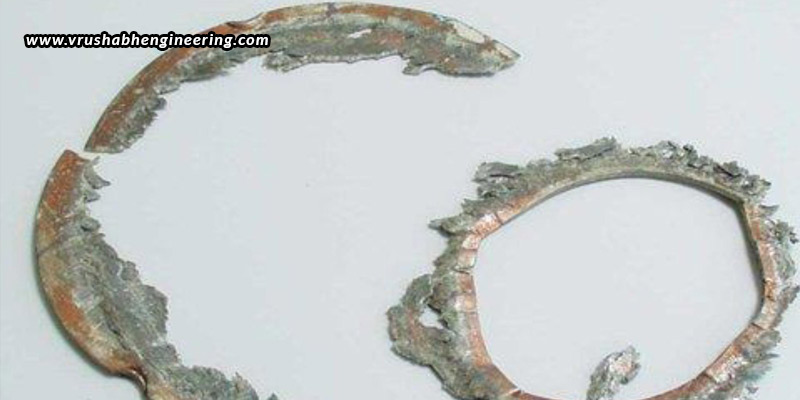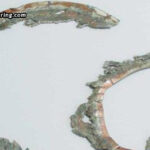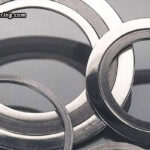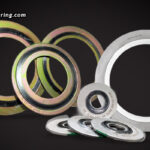Even a single gasket failure can lead to catastrophic leaks, causing safety incidents and halting critical industrial operations. While spiral wound gaskets are designed to perform even in the most demanding conditions of extreme temperatures, pressures, loads, and vibrations, they are not completely immune to failure. Wrong material selections, incorrect installation, and improper handling can all lead to premature failing of these gaskets.
Causes of spiral wound gasket failure
- Material incompatibility
Using unsuitable gasket materials can cause rapid degradation, leading to leaks, reduced sealing efficiency, and potential safety hazards. Incompatible materials may react with process fluids or fail under temperature and pressure variations, resulting in premature wear, frequent replacements, and costly system downtime in critical industrial applications.
Corrective action: Verify the material’s chemical compatibility with process fluids and refer to manufacturer charts. Opt for advanced alloys like Inconel with graphite fillers for challenging applications.
- Incorrect gasket dimensions
Using a gasket that does not match the flange dimensions can significantly impair sealing effectiveness. Gaskets that are too large may wear down, while those that are too small can create gaps that result in blowouts. Misalignment during installation can diminish the gasket’s capacity to sustain pressure, which can ultimately lead to premature failure.
Corrective action: Verify that gasket dimensions are consistent with flange specifications and standards. For specialized or non-standard applications, consider using custom-fabricated gaskets to ensure a precise fit and reliable sealing performance.
- Improper installation practices
Installation error is another cause of premature gasket failure. Even a high-quality gasket can fail if there is uneven bolt torque or misalignment of the flange. Over-tightening may damage the gasket, while under-tightening can result in leaks.
Corrective action: Always adhere to the manufacturer’s torque specifications, utilize calibrated tools, tighten bolts uniformly, and examine flange surfaces for any damage or debris prior to installation to guarantee effective sealing.
- Improper storage and handling
Gaskets can lose their integrity when subjected to sunlight, moisture, or physical stress during storage, which can warp the metal rings and degrade the filler materials. Contamination from oils or debris can further undermine sealing efficiency, often resulting in leaks and premature failure.
Corrective action: Store gaskets flat in a cool, dry area away from sunlight. Keep them sealed in their original packaging and handle them with clean gloves to avoid contamination and damage.
- Flange surface irregularities
Damaged or uneven flange surfaces can hamper gasket performance. Any kind of scratches, pitting, or warping can create uneven contact, resulting in leaks and gasket wear. Such imperfections prevent uniform compression, leading to premature failure.
Corrective action: Regularly inspect flange surfaces and ensure finishes meet required standards. Repair or replace damaged or corroded flanges before installation to maintain proper sealing and prevent premature gasket failure.
- Over-compression or under-compression
Improper compression can also harm the gasket. Excessive torque can flatten the windings and push out filler material, which weakens the seal; and insufficient compression does not create enough pressure to stop leakage. Both scenarios shorten the gasket’s lifespan and reduce sealing efficiency.
Corrective action: Implement outer centring rings to avoid over-tightening, gradually tighten bolts in uniform increments, and use torque-controlled tools to ensure precise compression levels.
- Thermal cycling and expansion
Frequent temperature changes in high-heat environments cause components to expand and contract. This results in loose bolts, diminished gasket compression, and can lead to creep relaxation and leakage during cooling or reheating. Repeated cycles accelerate gasket fatigue and sealing loss.
Corrective action: Choose graphite-filled spiral wound gaskets for high-temperature resilience. Retorque bolts after initial operation to maintain consistent compression and sealing integrity.
- Chemical attack and corrosion
Exposure to corrosive substances gradually deteriorates gasket materials. Halides can damage stainless steel, acidic vapours can oxidize graphite, and trapped moisture can speed up corrosion at flange joints. This degradation weakens both the gasket and the flanges, raising the risk of leakage and increasing maintenance needs.
Corrective action: Use nickel-based alloys such as Monel or Inconel combined with PTFE fillers for enhanced chemical resistance. Store gaskets in dry, clean environments to avoid premature corrosion.
Mechanical vibration and dynamic loads
Continuous vibration can lead to the loosening of bolts and gasket fatigue over time. The repeated movement of flanges and cyclic stress gradually results in leakage, visible damage to the outer rings of the gasket, and compromised sealing efficiency and the reliability of the system.
Corrective action: Use anti-vibration bolt locking systems and utilize reinforced gaskets with both inner and outer rings to effectively withstand mechanical stress, ensuring long-term sealing stability and structural integrity.
- Improper re-torquing and maintenance
Failing to re-torque bolts after installation leads to a gradual loss of compression. As the gasket settles or experiences temperature changes, the tension in the bolts diminishes, creating small gaps that can evolve into leaks or blowouts over time, putting safety and performance at risk in pressurized systems.
Corrective action: Retorque bolts once the system has reached its operating temperature and again after 24 hours. Perform regular maintenance to identify early signs of loosening, leakage, or compression loss before any failure occurs.
Detecting, understanding, and preventing spiral wound gasket failure
- Early warning signs of spiral wound gasket failure
Recognizing the initial signs of gasket failure is essential to prevent expensive downtime. Signs to look for include visible fluid or vapor leaks around the flange, corrosion marks, filler extrusion, and the need for frequent bolt tightening. Unusual vibrations or noises in pressurized systems often indicate joint instability that requires immediate inspection and corrective measures.
- Consequences of ignoring gasket failure
Neglecting gasket problems can lead to significant safety and operational risks. Leaks can result in equipment damage, production losses, and environmental pollution. In severe situations, there is a risk of fires, explosions, or toxic exposure. Ongoing neglect may also result in regulatory fines, highlighting the importance of timely monitoring and maintenance.
- Preventing premature gasket failure
Prevention begins with choosing materials that are compatible with the process environment. Ensuring clean, defect-free flange surfaces and applying the correct torque are vital for effective sealing. Reducing thermal and mechanical stress through the use of flexible couplings and regular bolt retorquing during maintenance helps guarantee reliable, long-term performance and avoids premature gasket failure.
Partnering with a reliable manufacturer
High-quality gaskets produced with precise winding and certified materials guarantee consistent performance. Even the most thorough maintenance program cannot make up for subpar manufacturing. Inconsistent winding, uneven filler density, or misaligned rings can greatly shorten gasket lifespan. Therefore, choosing a reliable gasket manufacturer is crucial for ensuring dependability. Vrushabh Engineering, a prominent spiral wound gasket manufacturer in India, creates high-performance gaskets designed to endure the most challenging industrial environments. Each gasket is meticulously crafted and tested for durability, providing reliable sealing, minimizing downtime, and enhancing operational safety across industries such as oil & gas, petrochemical, and power generation.
Spiral wound gaskets are designed for strength, flexibility, and resilience, but they achieve optimal performance only when properly selected, installed, and maintained. Most premature failures can be attributed to preventable issues – from improper torque application and flange irregularities to inappropriate materials or lack of maintenance. By implementing a proactive strategy, industries can significantly lower leakage risks, avert downtime, and secure long-term reliability. Ultimately, comprehending the reasons behind spiral wound gasket failures is the initial step toward preventing them.






